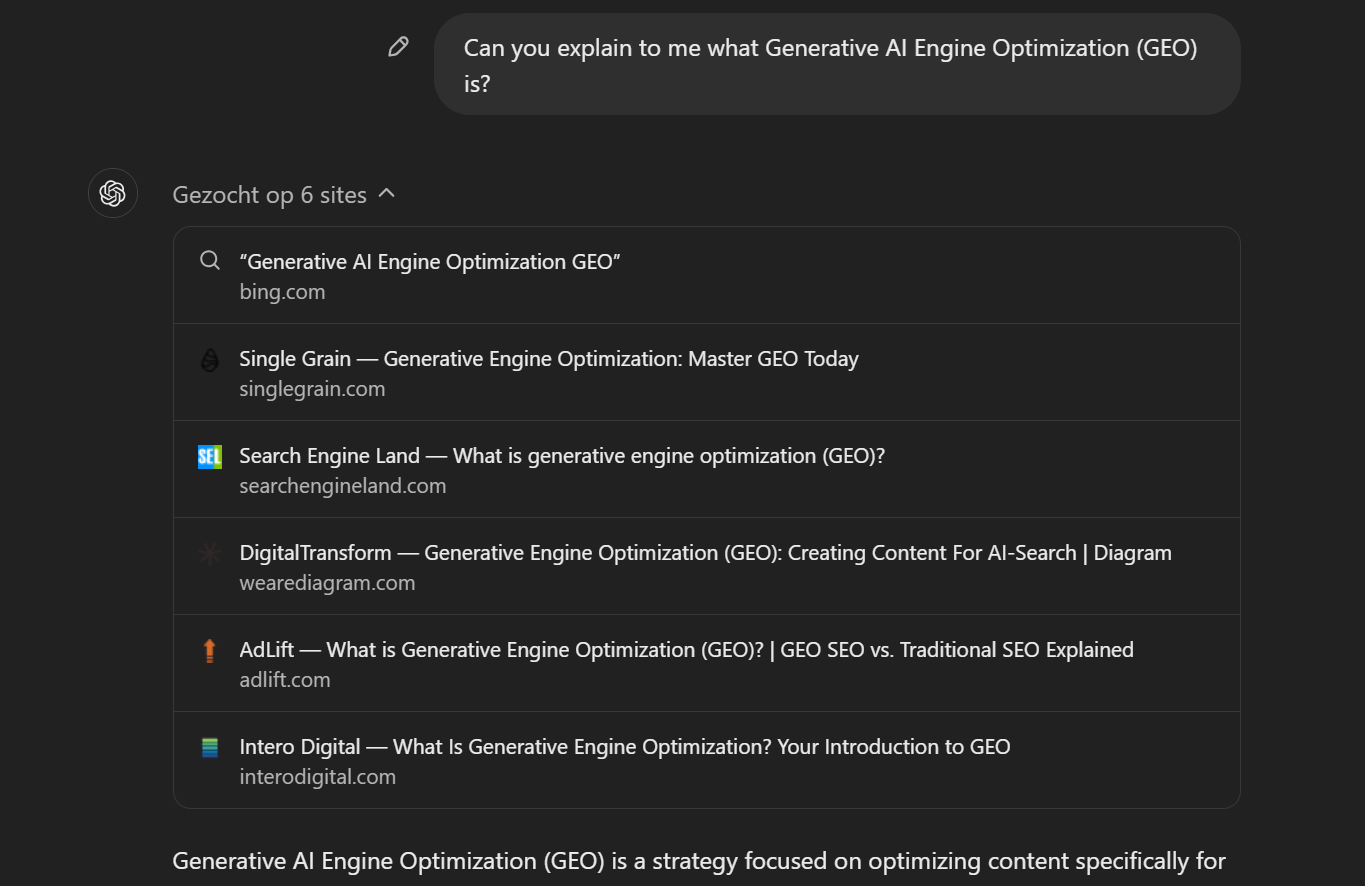Generative Engine Optimization (GEO) is a content optimization strategy designed to ensure that your content is visible and usable in AI-driven platforms like Anthropic, ChatGPT, Copilot, and Gemini. Your content can be utilized within the AI models or retrieved through specific user commands in your preferred AI tool. Depending on your outlook on the future, GEO is a strategy that should definitely be considered when creating online content.
Why you should know about Generative Engine Optimization (GEO)
Some familiar concepts from SEO apply to GEO, but the key difference is that your content must be of the highest quality to remain relevant. This is especially true when showcasing your expertise in B2B sectors, particularly in digital services. By incorporating GEO into your content strategy, you can prepare for the future and position yourself as a forward-thinking leader.
Research by Gartner shows that the future of search is shifting, with a predicted 25% decline in searches through Google. Think about how you used to turn to Google for all your answers. Today, many of us ask AI tools like ChatGPT instead. Although there are concerns about AI hallucinations, Google has also been known to provide incorrect information. Technically, much of the data comes from the same sources.
This growing shift toward using AI tools for information searches underscores the importance of understanding GEO and implementing it. An additional benefit of GEO is that it can also positively impact your SEO rankings.
The future of online search
Recent developments in AI show that we are moving toward speech-to-text interfaces, resulting in tools like ChatGPT-4o, where you can converse with AI. This technology is now integrated into mobile devices, with companies like Apple and Samsung introducing Apple Intelligence and Samsung Intelligence. This means that Siri and similar AI assistants can now execute commands more effectively. You no longer need to type in your questions—just ask your phone’s AI assistant to help, much like a personal assistant.
Statistics show that more than half of all Google searches come from mobile devices, and according to Statista, this trend has stabilized above 50% in recent years. While not everyone will have access to phones equipped with advanced AI personal assistants, the shift is happening, and many of us will want one. As major tech companies predict this trend to continue, you must ensure your online content is of high quality. A straightforward way to stay relevant in both GEO and SEO is to apply the E-E-A-T (Experience, Expertise, Authoritativeness, and Trustworthiness) principle when creating multilingual content.
How do we know if it works?
This is where it gets tricky. Many creators, artists, and writers have expressed concerns about how their data is being used by tech companies in large language models. As a marketer, you might be excited to see your content used in these models. However, as these models grow, so do their energy requirements, and tech companies now aim to keep models smaller to reduce costs.
In traditional SEO, we rely on updates from major search players. However, companies like OpenAI keep their processes more opaque, which has led to concerns, including from EU regulators and even Co-Founder Elon Musk. As a result, we can only speculate about how content is being used in these large language models.
Where GEO truly differs from SEO is in how it requires analyzing AI-generated content structures, topics, and citation patterns, and how they evolve over time. It involves crafting content that is easily parsed and utilized by AI, including structured data and formats suited for natural language processing.
Tip: Compare results from Google and an AI console when you ask the same question. In most cases, the sources differ. Look for commonalities between the results and consider why certain content works in both scenarios. Use this to refine your content strategy.

What should you be doing?
Some key players in the SEO landscape are already pivoting toward implementing GEO strategies. Ideally, SEO and GEO work hand-in-hand, allowing you to optimize content for both types of search engines. For example, if you search for “GEO” on Google and ChatGPT, one standout result is Search Engine Land’s explanation, which has been a trusted resource for SEO for years.
To get ahead of the curve, consider applying the following strategies:
- Generative AI research and analysis
- Content quality and relevance
- Content structure and clarity
- Content distribution and engagement
- Brand authority and credibility
- Technical SEO (which also applies to GEO)
By implementing these strategies, you not only improve your chances of appearing in AI-generated results but also maintain a strong presence in traditional online search engines.
Assisting you in getting ahead of the curve
At Linguatech, we believe this shift toward AI-driven search is a positive development. The quality of content is improving, and AI is validating information more rigorously, pushing organizations to publish higher-quality content. However, staying relevant as a brand or organization in a world where content can be created instantly is the real challenge.
Reassessing your content strategy for future relevance is crucial in this constantly evolving marketing landscape. This doesn’t just mean writing for GEO; it also involves thinking about how you create, validate, and utilize your content. Content creation is becoming increasingly important at the executive level, and issues like budget, volume, efficiency, and automation will become hot topics in the coming years.
